How Ecosystem Services Can Strengthen the Regeneration Policies for Monumental Olive Groves Destroyed by Xylella fastidiosa Bacterium in a Peri-Urban Area
Abstract
:1. Introduction
2. Materials and Methods
2.1. Study Area
2.2. Methodology
2.2.1. Land-Cover and Land-Use Characterization
2.2.2. Cultural Value and Assessment of Disease Severity
2.2.3. Ecosystem Services Resilience
2.2.4. Microclimate Regulation and Thermal Comfort
3. Results
3.1. Cultural Value and Disease Severity Analysis
3.2. Analysis of the Ecosystem Services Resilience
3.2.1. Analysis of Microclimate Regulation and Thermal Comfort Lost from Monumental Olive Groves Land-Cover to Grassland Land-Cover
3.2.2. Analysis of Microclimate Regulation Resilience from Land-Cover with Monumental Olive Groves to New Land-Cover of Leccino Olive Groves
4. Discussion
5. Concluding Remarks
Author Contributions
Funding
Institutional Review Board Statement
Informed Consent Statement
Data Availability Statement
Acknowledgments
Conflicts of Interest
References
- Antrop, M. Landscape Change: Plan or Chaos? Landsc. Urban Plan. 1998, 41, 155–161. [Google Scholar] [CrossRef]
- Maggiore, G.; Semeraro, T.; Aretano, R.; De Bellis, L.; Luvisi, A. GIS Analysis of land-use change in threatened landscapes by Xylella fastidiosa. Sustainability 2019, 11, 253. [Google Scholar] [CrossRef] [Green Version]
- Dean, G.; Rivera-Ferre, M.G.; Rosas-Casals, M.; Lopez-i-Gelats, F. Nature’s contribution to people as a framework for examining socio-ecological systems: The case of pastoral systems. Ecosyst. Serv. 2021, 49, 101265. [Google Scholar] [CrossRef]
- Wu, J.; Hobbs, R.J. Key Issues and Research Priorities in Landscape Ecology: An Idiosyncratic Synthesis. Landsc. Ecol. 2002, 17, 355–365. [Google Scholar] [CrossRef]
- Virapongse, A.; Brooks, S.; Metcalf, E.C.; Zedalis, J.G.; Kliskey, A.; Alessa, L. A social-ecological systems approach for environmental management. J. Environ. Manag. 2016, 178, 83–91. [Google Scholar] [CrossRef] [PubMed] [Green Version]
- Mao, Z.; Centanni, J.; Pommereau, F.; Stokes, A.; Gaucherel, C. Maintaining biodiversity promotes the multifunctionality of social-ecological systems: Holistic modelling of a mountain system. Ecosyst. Serv. 2021, 47. [Google Scholar] [CrossRef]
- Turner, B.L.; Meyer, W.B. Land-use and land-cover in global environmental change: Considerations for study. Int. Soc. Sci. J. 1991, 130, 667–669. [Google Scholar]
- Brown, D.G.; Pijanowski, B.C.; Duh, J.D. Modeling the relationships between land-use and land-cover on private lands in the Upper Midwest, USA. J. Environ. Manage. 2000, 59, 247–263. [Google Scholar] [CrossRef] [Green Version]
- Haines-Young, R.; Potschin, M. Valuing and assessing multifunctional landscapes: An approach based on the natural capital concept. In Multifunctional Landscapes: Theory, Values and History; Brandt, J., Vejre, H., Eds.; WIT Press: Southampton, UK, 2004; pp. 181–192. [Google Scholar]
- Antrop, M. Background concepts for integrated landscape analysis. Agric. Ecosyst. Environ. 2000, 77, 17–28. [Google Scholar] [CrossRef]
- UNESCO. Operational Guidelines for the Implementation of the World Heritage Convention Copia whc.unesco.org. UNESCO World Heritage Centre. Paris. 2005, p. 83. Available online: https://whc.unesco.org/archive/opguide05-en.pdf (accessed on 4 August 2021).
- Cumming, G.S.; Epstein, G. Landscape sustainability and the landscape ecology of institutions. Landsc. Ecol. 2020. [Google Scholar] [CrossRef]
- Regione Puglia. 2021. Available online: https://www.regione.puglia.it/web/rigenerazione-olivicola (accessed on 24 June 2021).
- Saponari, M.; Boscia, D.; Nigro, F.; Martelli, G.P. Identification of DNA sequences related to Xylella fastidiosa in oleander, almond and olive trees exhibiting leaf scorch symptoms in Apulia (Southern Italy). J. Plant Pathol. 2013, 95, 668. [Google Scholar]
- Martelli, G.P. The current status of the quick decline syndrome of olive in Southern Italy. Phytoparasitica 2016, 44, 1–10. [Google Scholar] [CrossRef]
- Semeraro, T.; Gatto, E.; Buccolieri, R.; Vergine, M.; Gao, Z.; De Bellis, L.; Luvisi, A. Changes in Olive Urban Forests Infected by Xylella fastidiosa: Impact on Microclimate and Social Health in urban areas. Int. J. Environ. Res. Pub. Health 2019, 16, 2642. [Google Scholar] [CrossRef] [PubMed] [Green Version]
- Semeraro, T.; Zaccarelli, N.; Lara, A.; Sergi-Cucinelli, F.; Aretano, R. A Bottom-Up and Top-Down Participatory Approach to Planning and Designing Local Urban Development: Evidence from an Urban University Center. Land 2020, 9, 98. [Google Scholar] [CrossRef] [Green Version]
- Carpenter, S.; Walker, B.; Anderies, J.M.; Abel, N. From metaphor to measurement: Resilience of what to what? Ecosystems 2001, 4, 765–781. [Google Scholar] [CrossRef]
- Walker, B.; Holling, C.S.; Carpenter, S.R.; Kinzig, A.P. Resilience, Adaptability and Transformability in Social-Ecological Systems. Ecol. Soc. 2004, 9, 5. Available online: http://www.ecologyandsociety.org/vol9/iss2/art5/ (accessed on 17 July 2021). [CrossRef]
- Broderstad, E.G.; Eythorsson, E. Resilient communities? Collapse and recovery of a social–ecological system in Arctic Norway. Ecol. Soc. 2004, 19, 1. [Google Scholar] [CrossRef] [Green Version]
- Ahern, J.; Cilliers, S.; Niemelä, J. The concept of ecosystem services in adaptive urban planning and design: A framework for supporting innovation. Landsc. Urban Plan. 2014, 125, 254–259. [Google Scholar] [CrossRef] [Green Version]
- Hughes, T.P.; Barnes, M.; Bellwood, D.R.; Cinner, J.; Cumming, G.; Jackson, J.B.C.; Kleypas, J.; Van De Leemput, I.A.; Lough, J.M.; Morrison, T.; et al. Coral reefs in the Anthropocene. Nat. Cell Biol. 2017, 546, 82–90. [Google Scholar] [CrossRef] [PubMed]
- Vergine, M.; Meyer, J.B.; Cardinale, M.; Sabella, E.; Hartmann, M.; Cherubini, P.; De Bellis, L.; Luvisi, A. The Xylella fastidiosa-Resistant Olive Cultivar “Leccino” Has Stable Endophytic Microbiota during the Olive Quick Decline Syndrome (OQDS). Pathogens 2019, 9, 35. [Google Scholar] [CrossRef] [PubMed] [Green Version]
- Sabella, E.; Moretti, S.; Gärtner, H.; Luvisi, A.; De Bellis, L.; Vergine, M.; Saurer, M.; Cherubini, P. Increase in ring width, vessel number and δ18O in olive trees infected with Xylella fastidiosa. Tree Physiol. 2020, 40, 1583–1594. [Google Scholar] [CrossRef]
- Kelly, C.; Ferrara, A.; Wilson, G.A.; Ripullone, F.; Nolè, A.; Harmer, N.; Salvati, L. Community resilience and land degradation in forest and shrubland socio ecological systems: Evidence from Gorgoglione, Basilicata, Italy. Land-Use Policy 2015, 46, 11–20. [Google Scholar] [CrossRef] [Green Version]
- Morton, J.F.; Solecki, W.; Dasgupta, P.; Dodman, D.; Rivera-Ferre, M.G. Cross chapter box on urban–rural interactions—Context for climate change vulnerability, impacts, and adaptation. In Climate Change: Impacts, Adaptation, and Vulnerability. Part A: Global and Sectoral Aspects. Contribution of Working Group II to the Fifth Assessment Report of the Intergovernmental Panel on Climate Change; Field, C.B., Barros, V.R., Dokken, D.J., Mach, K.J., Mastrandrea, M.D., Bilir, T.E., Chatterjee, M., Ebi, K.L., Estrada, Y.O., Genova, R.C., Eds.; Cambridge University Press: Cambridge, UK; New York, NY, USA, 2014; pp. 153–155. [Google Scholar]
- Carrasco, L.; Papworth, S.; Reed, J.; Symes, W.; Ickowitz, A.; Clements, T.; Peh, K.-H.; Sunderland, T. Five challenges to reconcile agricultural land use and forest ecosystem services in Southeast Asia. Conserv. Biol. 2016, 30, 962–971. [Google Scholar] [CrossRef] [Green Version]
- Wilkerson, M.L.; Mitchell, M.G.; Shanahan, D.; Wilson, K.; Ives, C.D.; Lovelock, C.; Rhodes, J. The role of socio-economic factors in planning and managing urban ecosystem services. Ecosyst. Serv. 2018, 31, 102–110. [Google Scholar] [CrossRef]
- Soto-Montes-De-Oca, G.; Bark, R.; González-Arellano, S. Incorporating the insurance value of peri-urban ecosystem services into natural hazard policies and insurance products: Insights from Mexico. Ecol. Econ. 2020, 169, 106510. [Google Scholar] [CrossRef]
- Salmond, J.A.; Tadaki, M.; Vardoulakis, S.; Arbuthnott, K.; Coutts, A.; Demuzere, M.; Dirks, K.N.; Heaviside, C.; Lim, S.; MacIntyre, H.; et al. Health and climate related ecosystem services provided by street trees in the urban environment. Environ. Health 2016, 15, S36. [Google Scholar] [CrossRef] [Green Version]
- Santamouris, M.; Ding, L.; Fiorito, F.; Oldfield, P.; Osmond, P.; Paolini, R.; Prasad, D.; Synnefa, A. Passive and active cooling for the built environment-Analysis and assessment of the cooling potential of mitigation technologies using performance data form 220 large scale projects. Sol. Energy 2017, 154, 14–33. [Google Scholar] [CrossRef]
- Plieninger, T.; Bieling, C.; Fagerholm, N.; Byg, A.; Hartel, T.; Hurley, P.; López-Santiago, C.A.; Nagabhatla, N.; Oteros-Rozas, E.; Raymond, C.; et al. The role of cultural ecosystem services in landscape management and planning. Curr. Opin. Environ. Sustain. 2015, 14, 28–33. [Google Scholar] [CrossRef] [Green Version]
- Chen, W.Y.; Hua, J. Heterogeneity in resident perceptions of a bio-cultural heritage in Hong Kong: A latent class factor analysis. Ecosyst. Serv. 2017, 24, 170–179. [Google Scholar] [CrossRef]
- Cheng, X.; Van Damme, S.; Li, L.; Uyttenhove, P. Evaluation of cultural ecosystem services: A review of methods. Ecosyst. Serv. 2019, 37, 100925. [Google Scholar] [CrossRef]
- De Groot, R.S.; Alkemade, R.; Braat, L.; Hein, L.; Willemen, L. Challenges in integrating the concept of ecosystem services and values in landscape planning, management and decision making. Ecol. Complex. 2010, 7, 260–272. [Google Scholar] [CrossRef]
- Costanza, R.; De Groot, R.; Braat, L.; Kubiszewski, I.; Fioramonti, L.; Sutton, P.; Farber, S.; Grasso, M. Twenty years of ecosystem services: How far have we come and how far do we still need to go? Ecosyst. Serv. 2017, 28, 1–16. [Google Scholar] [CrossRef]
- Semeraro, T.; Radicchio, B.; Medagli, P.; Arzeni, S.; Turco, A.; Geneletti, D. Integration of Ecosystem Services in Strategic Environmental Assessment of a Peri-Urban Development Plan. Sustainability 2020, 13, 122. [Google Scholar] [CrossRef]
- Vallecillo, S.; La Notte, A.; Ferrini, S.; Maes, J. How ecosystem services are changing: An accounting application at the EU level. Ecosyst. Serv. 2019, 40, 101044. [Google Scholar] [CrossRef]
- Rall, E.L.; Kabisch, N.; Hansen, R. A comparative exploration of uptake and potential application of ecosystem services in urban planning. Ecosyst. Serv. 2015, 16, 230–242. [Google Scholar] [CrossRef]
- Turkelboom, F.; Leone, M.; Jacobs, S.; Kelemen, E.; García-Llorente, M.; Baró, F.; Termansen, M.; Barton, D.N.; Berry, P.; Stange, E.; et al. When we cannot have it all: Ecosystem services trade-offs in the context of spatial planning. Ecosyst. Serv. 2018, 29, 566–578. [Google Scholar] [CrossRef]
- Dang, A.N.; Jackson, B.M.; Benavidez, R.; Tomscha, S.A. Review of ecosystem service assessments: Pathways for policy integration in Southeast Asia. Ecosyst. Serv. 2021, 49, 101266. [Google Scholar] [CrossRef]
- Collins, S.L.; Carpenter, S.R.; Swinton, S.M.; Orenstein, D.; Childers, D.; Gragson, T.L.; Grimm, N.; Grove, J.M.; Harlan, S.L.; Kaye, J.P.; et al. An integrated conceptual framework for long-term social–ecological research. Front. Ecol. Environ. 2010, 9, 351–357. [Google Scholar] [CrossRef] [Green Version]
- Bodin, Ö.; Tengo, M. Disentangling intangible social–ecological systems. Glob. Environ. Chang. 2012, 22, 430–439. [Google Scholar] [CrossRef]
- Berrouet, L.; Machado, J.; Villegas-Palacio, C. Vulnerability of socio—Ecological systems: A conceptual Framework. Ecol. Indic. 2018, 84, 632–647. Available online: https://www.istat.it/it/archivio/32618 (accessed on 15 June 2021). [CrossRef]
- Turner, B.L.; Skole, D.; Sanderson, S.; Fischer, G.; Fresco, L.; Leemans, R. Land-Use and Land-Cover Change Science/Research Plan. In Joint Publication of the International Geosphere-Biosphere Programme (Report No. 35) and the Human Dimensions of Global Environmental Change Programme (Report No. 7); Royal Swedish Academy of Sciences: Stockholm, Sweden, 1995. [Google Scholar]
- Bishop, J. The Economics of Ecosystems and Biodiversity in Business and Enterprise, 1st ed.; Routledge: London, UK, 2021. [Google Scholar] [CrossRef]
- Houdet, J.; Ding, H.; Quétier, F.; Addison, P.; Deshmukh, P. Adapting double-entry bookkeeping to renewable natural capital: An application to corporate net biodiversity impact accounting and disclosure. In Ecosyst. Serv.; 2020; 45, p. 101104. Available online: https://www.agenziaentrate.gov.it/portale/home/ (accessed on 15 June 2021). [CrossRef]
- Nicolì, F.; Negro, C.; Nutricati, E.; Vergine, M.; Aprile, A.; Sabella, E.; Damiano, G.; De Bellis, L.; Luvisi, A. Accumulation of azelaic acid in Xylella fastidiosa-infected olive trees: A mobile metabolite for health screening. Phytopathology 2019, 109, 318–325. [Google Scholar] [CrossRef] [PubMed] [Green Version]
- Luvisi, A.; Aprile, A.; Sabella, E.; Vergine, M.; Nicolì, F.; Nutricati, E.; Miceli, A.; Negro, C.; De Bellis, L. Xylella fastidiosa subsp. pauca (CoDiRO strain) infection in four olive (Olea europaea L.) cultivars: Profile of phenolic compounds in leaves and progression of leaf scorch symptoms. Phytopathol. Mediterr. 2017, 56, 259–273. [Google Scholar]
- Edwards, K.; Johnstone, C.; Thompson, C. A simple and rapid method for the preparation of plant genomic DNA for PCR analysis. Nucleic Acids Res. 1991, 19, 1349. [Google Scholar] [CrossRef] [PubMed]
- Harper, S.J.; Ward, L.I.; Clover, G.R.G. Development of LAMP and real-time PCR methods for the rapid detection of Xylella fastidiosa for quarantine and field applications. Phytopathology 2010, 100, 1282–1288. [Google Scholar] [CrossRef] [PubMed]
- De Groot, R.S.; Wilson, M.; Boumans, R. A typology for the description, classification and valuation of Ecosystem Functions. Goods Serv. Econ. 2002, 41, 393–408. [Google Scholar]
- Gatto, E.; Buccolieri, R.; Aarrevaara, E.; Ippolito, F.; Emmanuel, R.; Perronace, L.; Santiago, J.L. Impact of Urban Vegetation on Outdoor Thermal Comfort: Comparison between a Mediterranean City (Lecce, Italy) and a Northern European City (Lahti, Finland). Forests 2020, 11, 228. Available online: http://www.arpa.puglia.it/web/guest/serviziometeo (accessed on 17 June 2021). [CrossRef] [Green Version]
- Rui, L.; Buccolieri, R.; Gao, Z.; Ding, W.; Shen, J. The impact of green space layouts on microclimate and air quality in residential districts of nanjing, China. Forests 2018, 9, 224. [Google Scholar] [CrossRef] [Green Version]
- Burkhard, B.; Kroll, F.; Nedkov, S.; Müller, F. Mapping ecosystem service supply, demand and budgets. Ecol. Indic. 2012, 21, 17–29. [Google Scholar] [CrossRef]
- Strohbacha, M.W.; Haaseb, D. Above-ground carbon storage by urban trees in Leipzig, Germany: Analysis of patterns in a European city. Land. Urban. Plan. 2012, 104, 95–104. [Google Scholar] [CrossRef]
- Kandziora, M.; Burkhard, B.; Müller, F. Mapping provisioning ecosystem services at the local scale using data of varying spatial and temporal resolution. Ecosyst. Serv. 2013, 4, 47–59. [Google Scholar] [CrossRef]
- Whitmarsh, J.G. The Photosynthetic Process. In Concepts in Photobiology; Singhal, G.S., Renger, G., Sopory, S.K., Irrgang, K.-D., Eds.; Springer: Dordrecht, The Netherlands, 1999. [Google Scholar] [CrossRef]
- Petrosillo, I.; Zaccarelli, N.; Semeraro, T.; Zurlini, G. The effectiveness of different conservation policies on the security of natural capital. Landsc. Urban Plan. 2009, 89, 49–56. [Google Scholar] [CrossRef]
- Vallés-Planells, M.; Galiana, F.; Torrijos, I.D. Agricultural abandonment and resilience in a Mediterranean periurban traditional agroecosystem: A landscape approach. Ecol. Soc. 2020, 25, 5. [Google Scholar] [CrossRef] [Green Version]
- Crane, T. Of Models and Meanings: Cultural Resilience in Social–Ecological Systems. Ecol. Soc. 2010, 15, 16. [Google Scholar] [CrossRef] [Green Version]
- Sabella, E.; Luvisi, A.; Aprile, A.; Negro, C.; Vergine, M.; Nicolì, F.; Miceli, A.; De Bellis, L. Xylella fastidiosa induces differential expression of lignification related-genes and lignin accumulation in tolerant olive trees cv. Leccino. J. Plant Physiol. 2018, 220, 60–68. [Google Scholar] [CrossRef] [PubMed]
- Folke, C. Resilience (Republished). Ecol. Soc. 2016, 21, 44. [Google Scholar] [CrossRef]
- Holling, C.S. The resilience of terrestrial ecosystems local surprise and global changeSustainable Development of the BiosphereClark, W.C., Munn, R.E., Eds.; Cambridge University Press: Cambridge, UK, 1986; pp. 292–317.
- Cecchini, M.; Zambon, I.; Pontrandolfi, A.; Turco, R.; Colantoni, A.; Mavrakis, A.; Salvati, L. Urban sprawl and the ‘olive’ landscape: Sustainable land management for ‘crisis’ cities. GeoJournal 2019, 84, 237–255. [Google Scholar] [CrossRef]
- Robert, S.; Fox, D.; Boulay, G.; Grandclément, A.; Garrido, M.; Pasqualini, V.; Prévost, A.; Schleyer-Lindenmann, A.; Trémélo, M.-L. A framework to analyse urban sprawl in the French Mediterranean coastal zone. Reg. Environ. Chang. 2019, 19, 559–572. [Google Scholar] [CrossRef]
- Salvia, R.; Halbac-Cotoara-Zamfir, R.; Cividino, S.; Salvati, L.; Quaranta, G. From Rural Spaces to Peri-Urban Districts: Metropolitan Growth, Sparse Settlements and Demographic Dynamics in a Mediterranean Region. Land 2020, 9, 200. [Google Scholar] [CrossRef]
- Fujita, R.; Lynham, J.; Micheli, F.; Feinberg, P.G.; Bourillón, L.; Sáenz-Arroyo, A.; Markham, A.C. Ecomarkets for conservation and sustainable development in the coastal zone. Biol. Rev. 2013, 88, 273–286. [Google Scholar] [CrossRef] [PubMed]
- Waylen, K.; Martin-Ortega, J. Surveying views on Payments for Ecosystem Services: Implications for environmental management and research. Ecosyst. Serv. 2018, 29, 23–30. [Google Scholar] [CrossRef]
- Brathwaite, A.; Pascal, N.; Clua, E. When are payment for ecosystems services suitable for coral reef derived coastal protection?: A review of scientific requirements. Ecosyst. Serv. 2021, 49, 101261. [Google Scholar] [CrossRef]
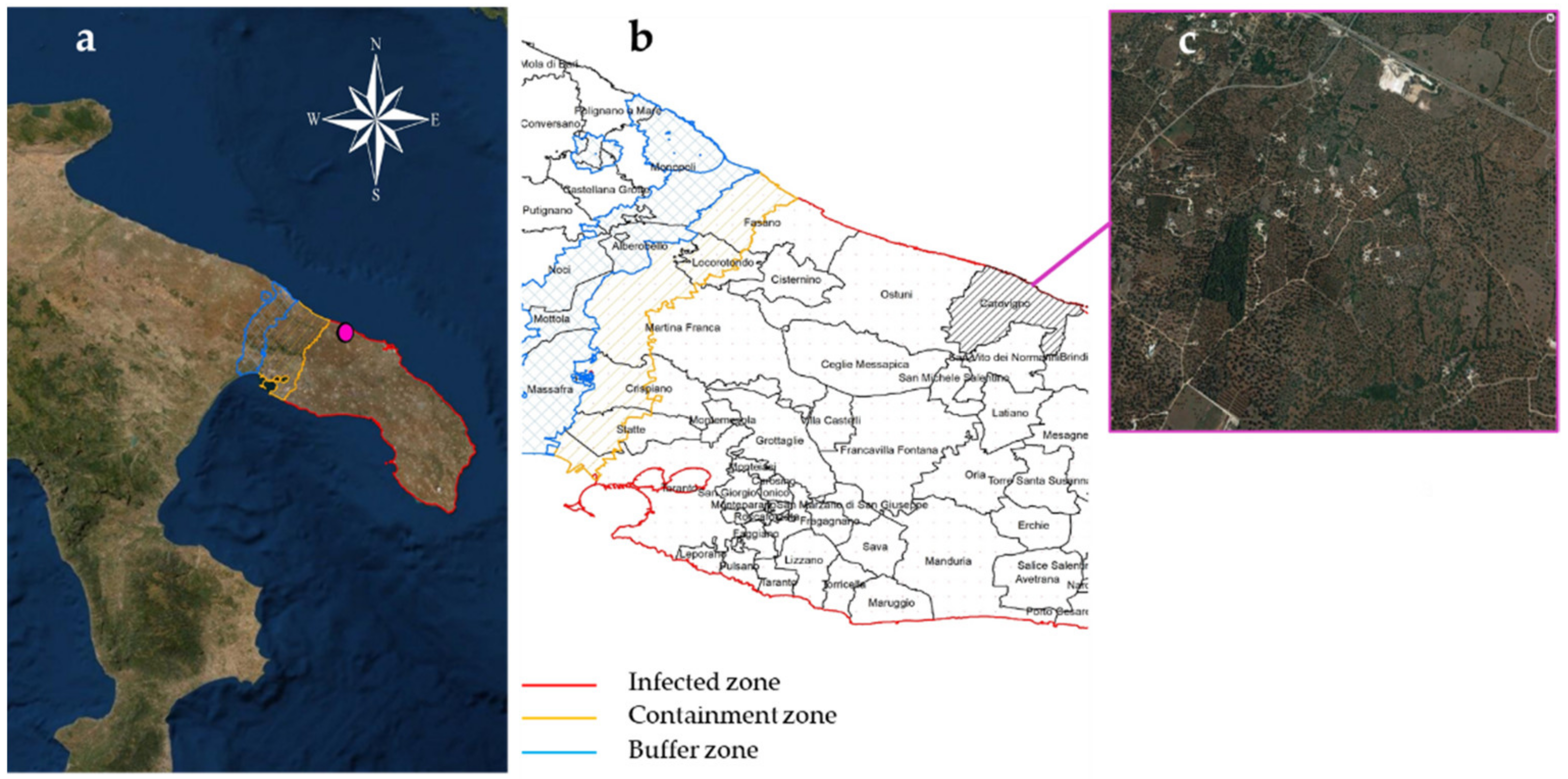
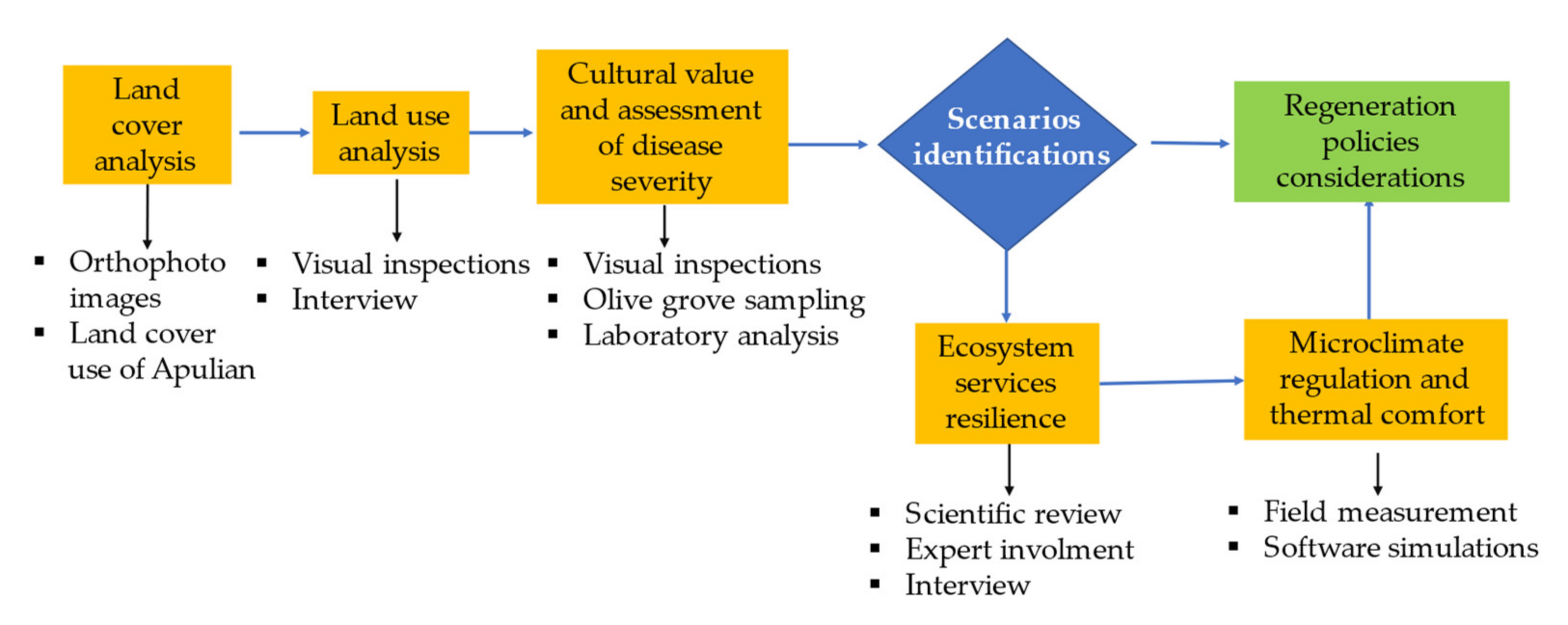
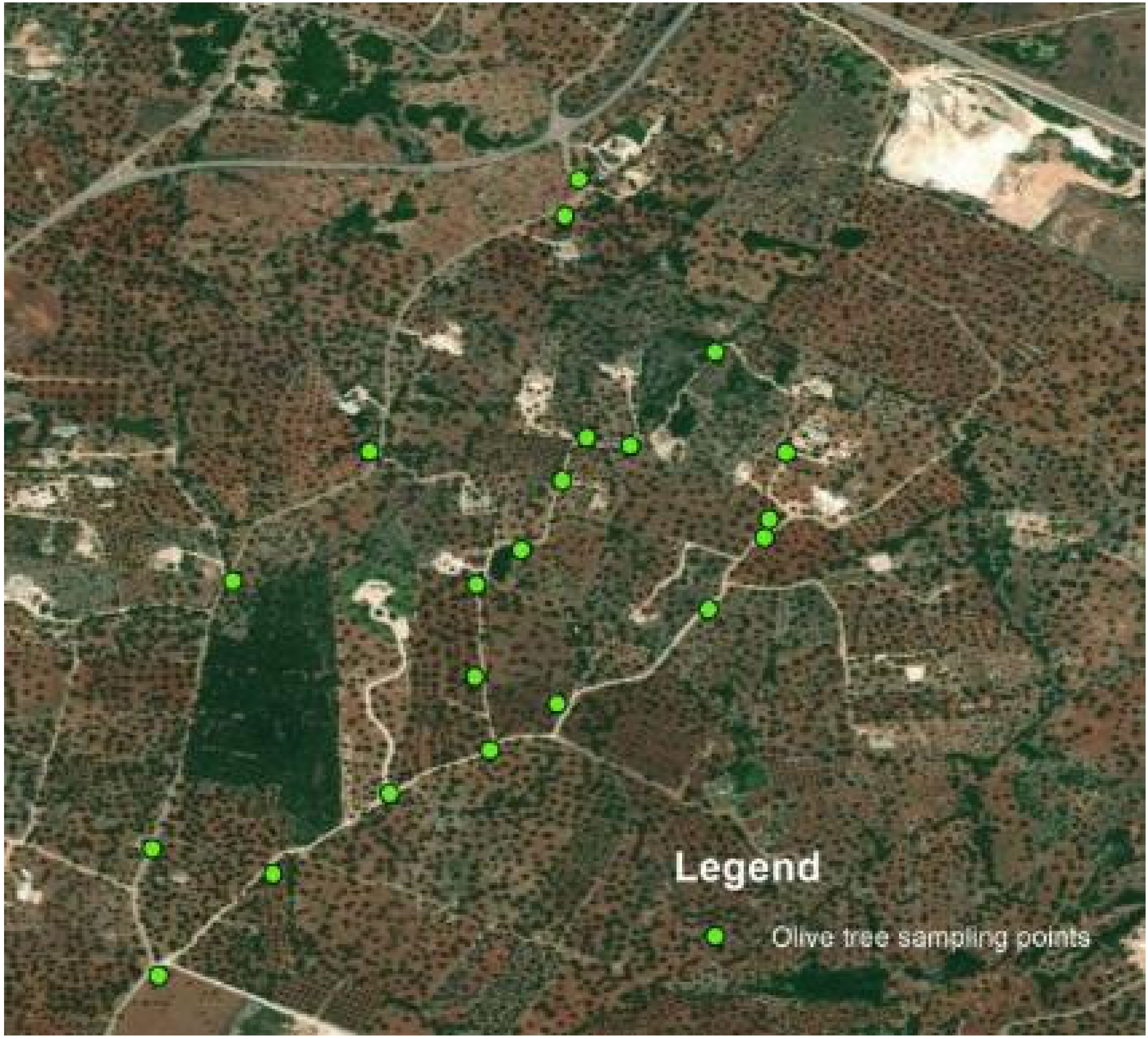
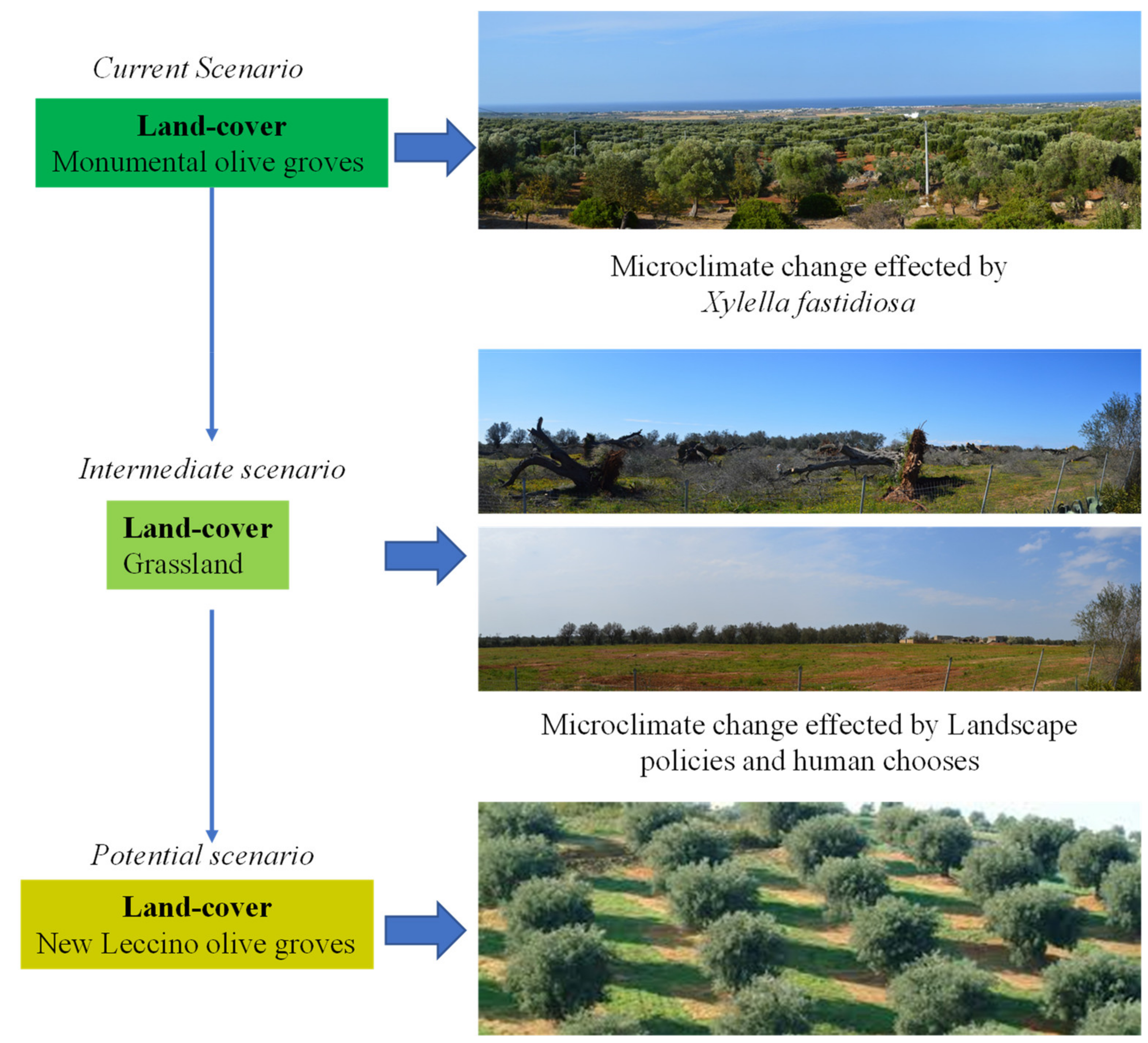
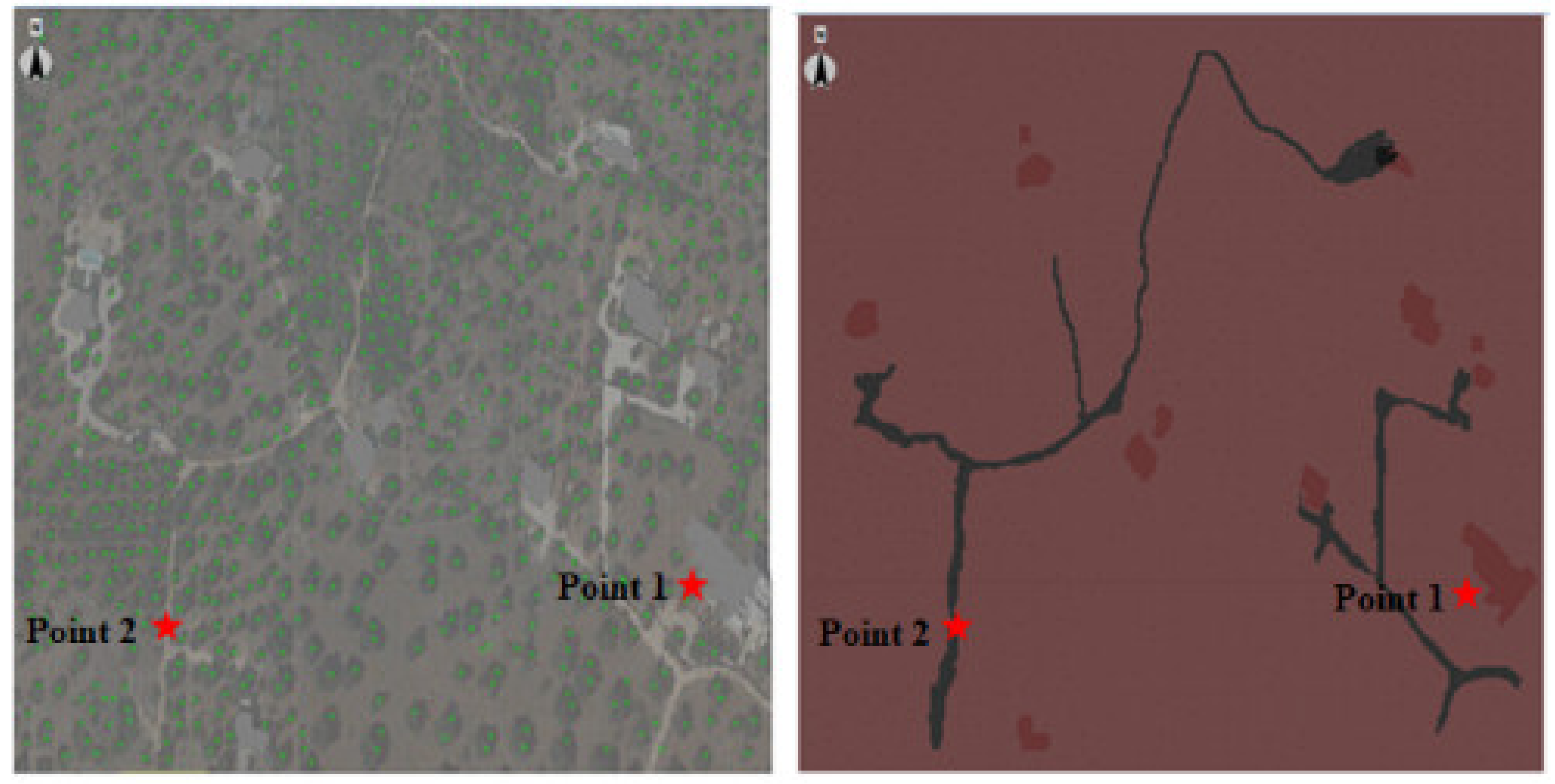
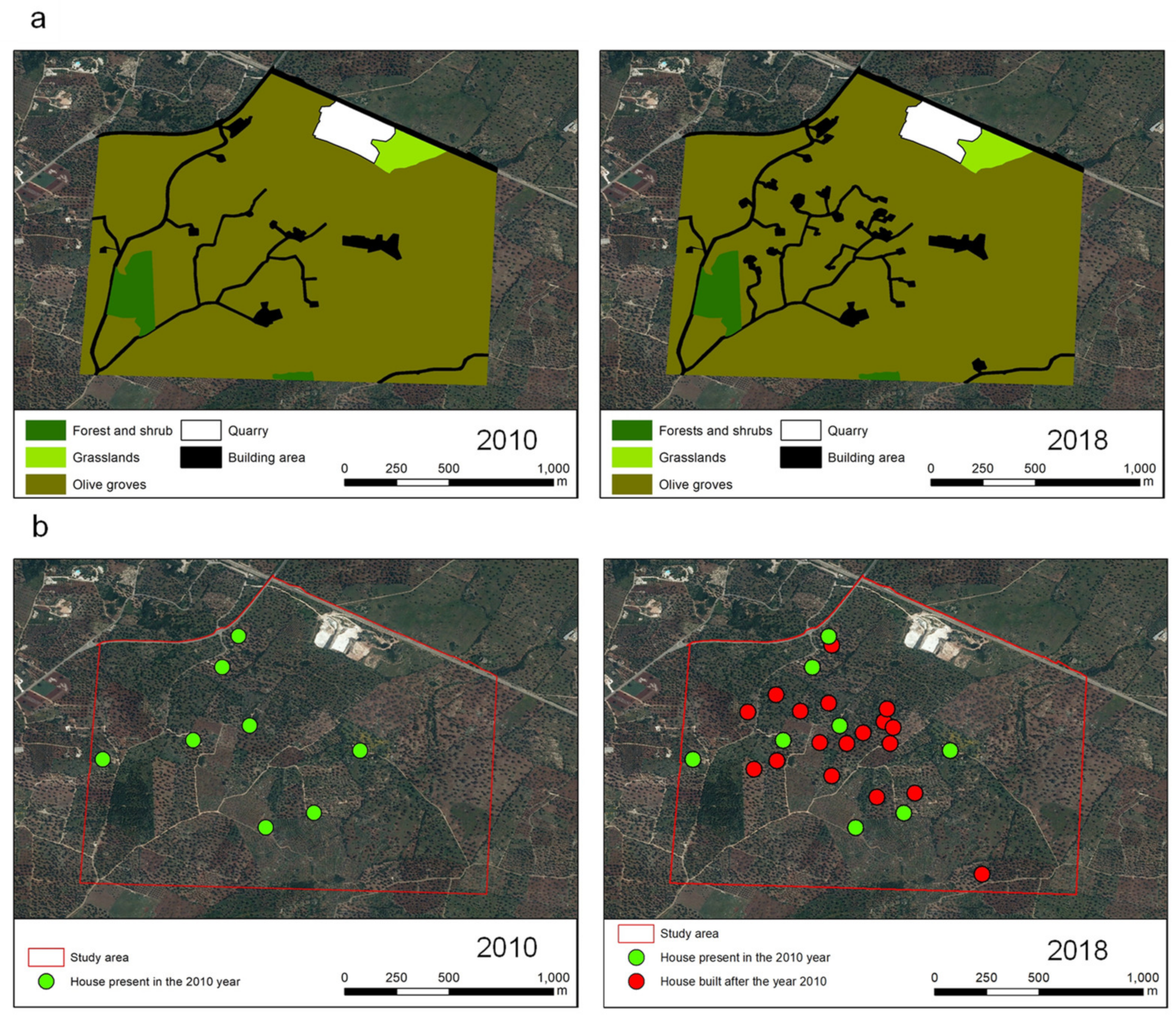
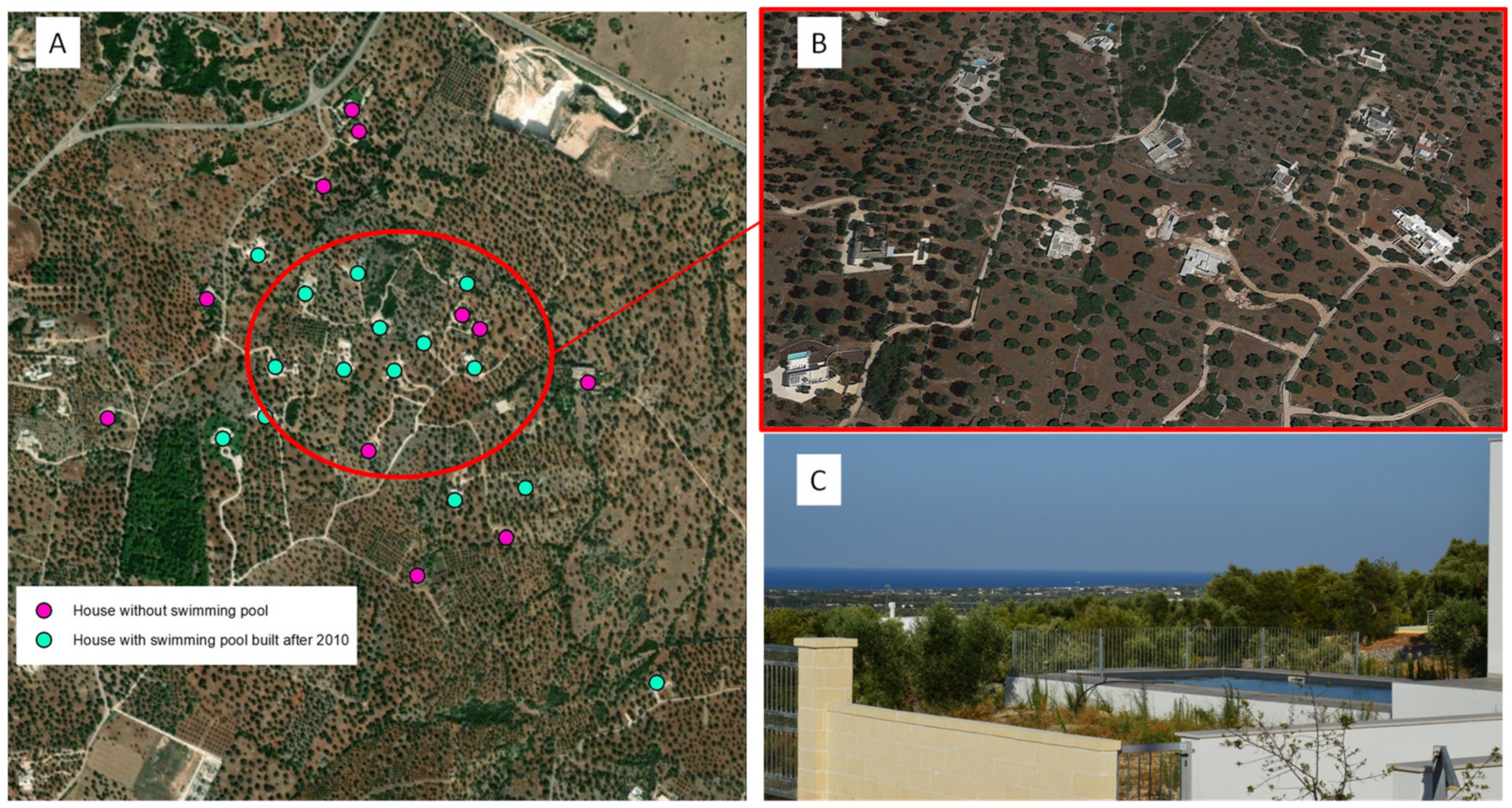
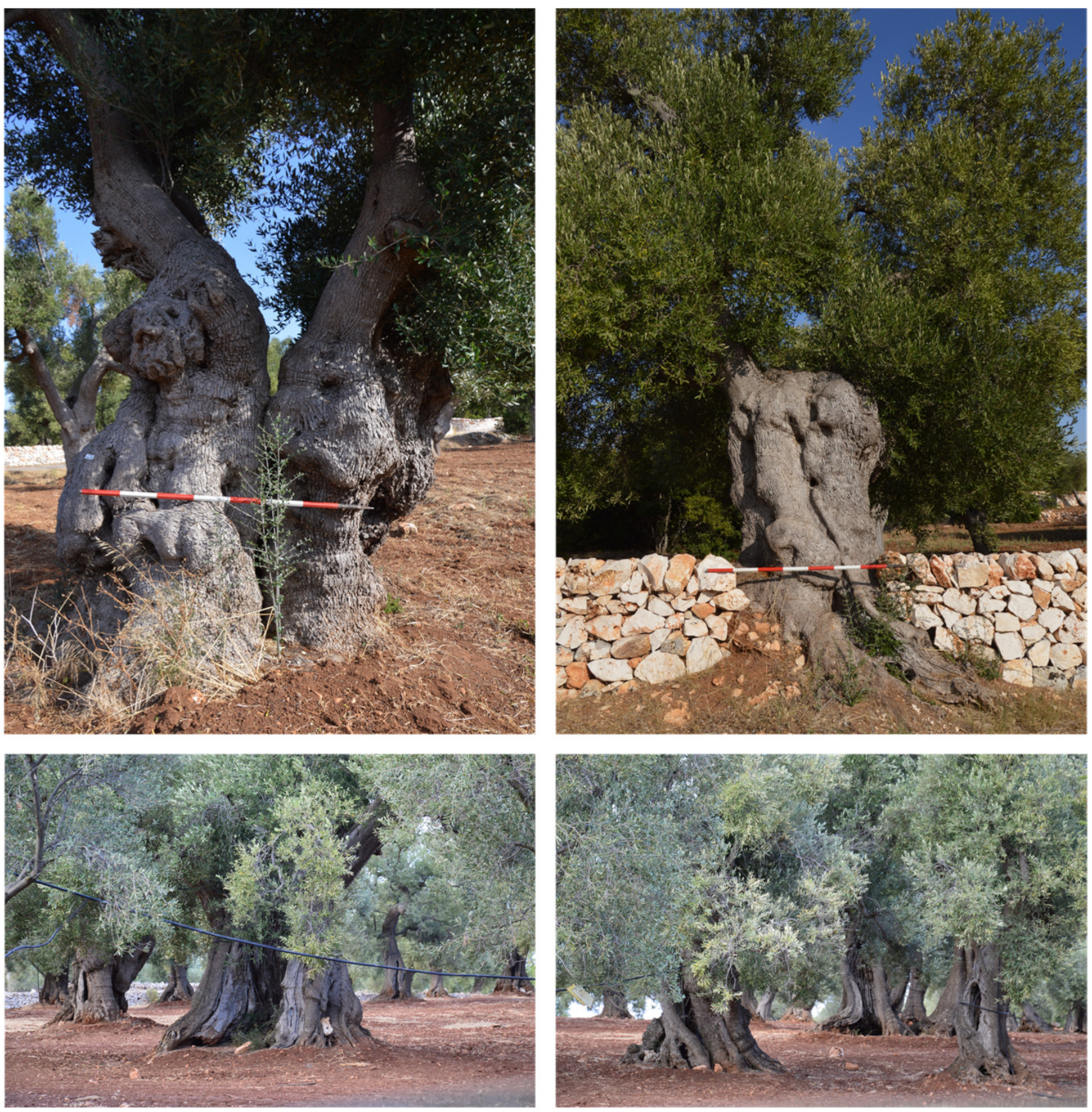
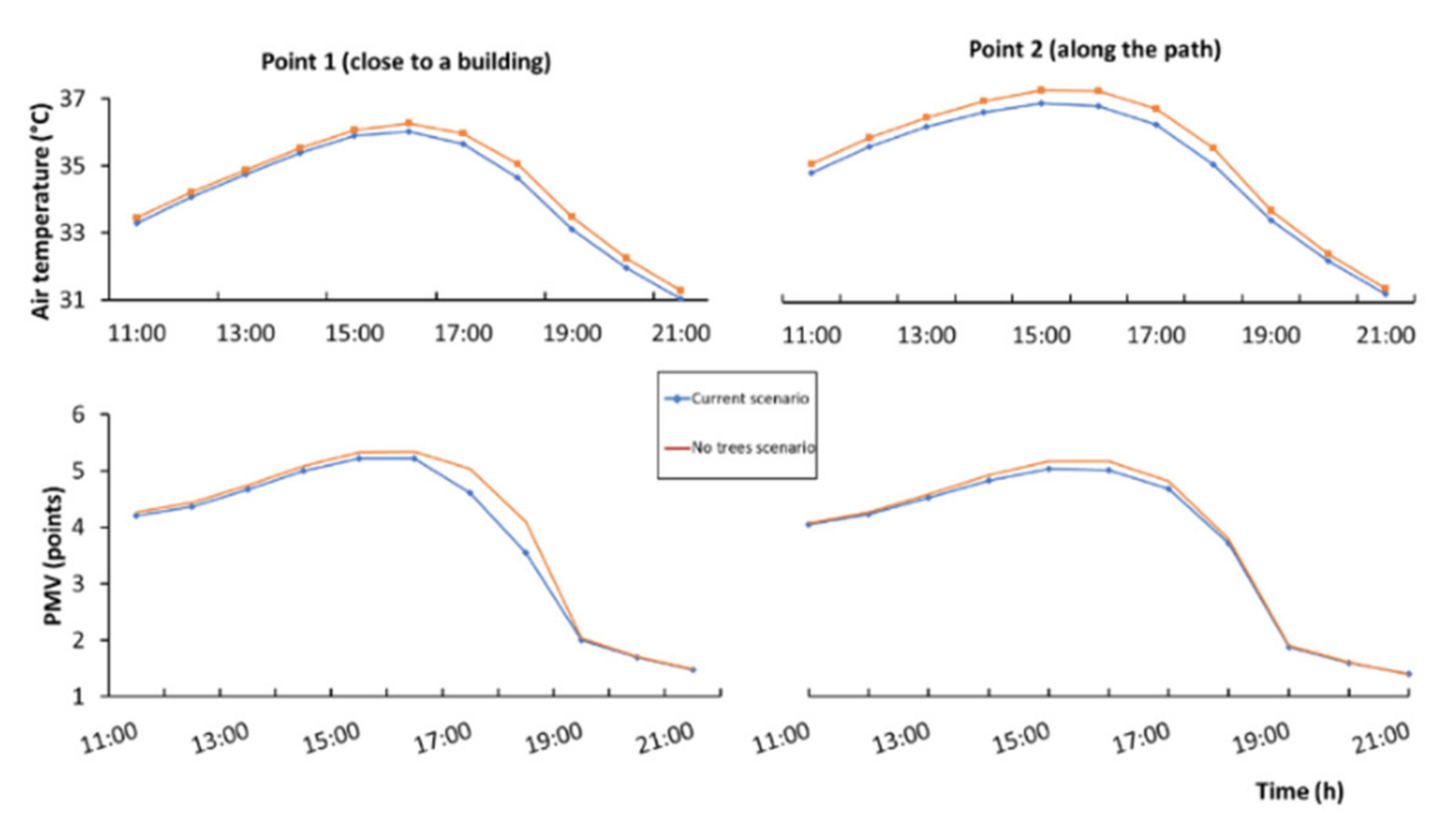
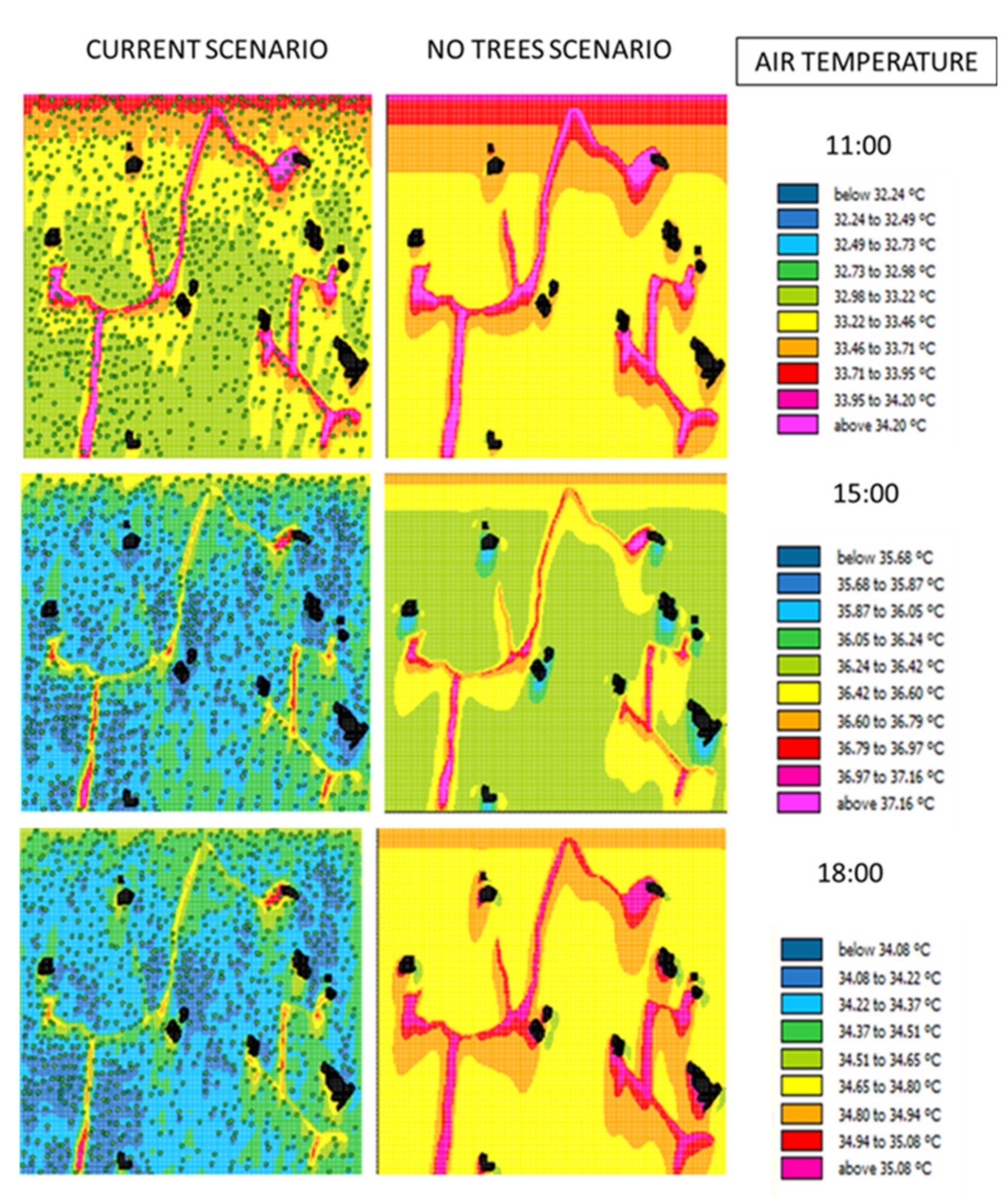
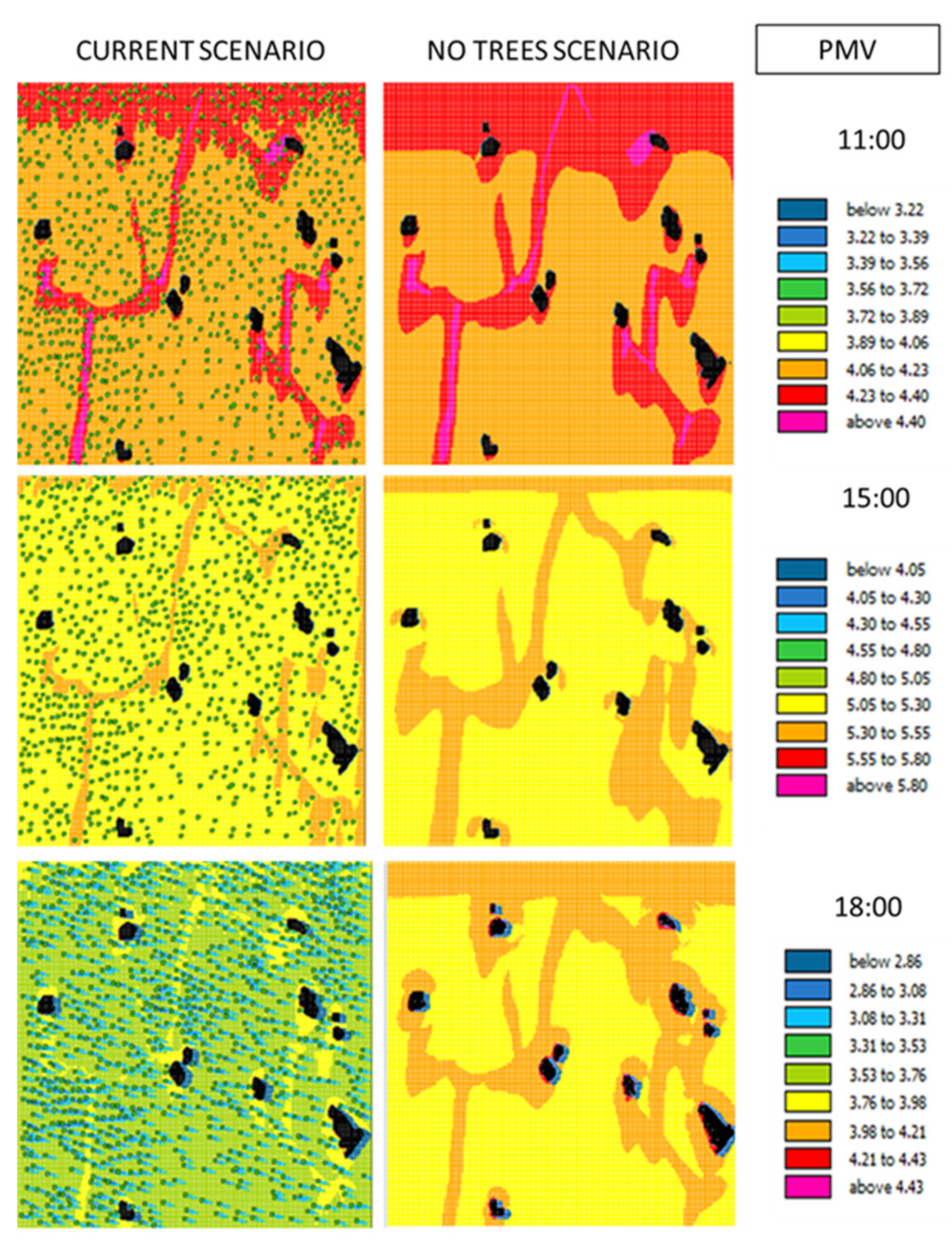
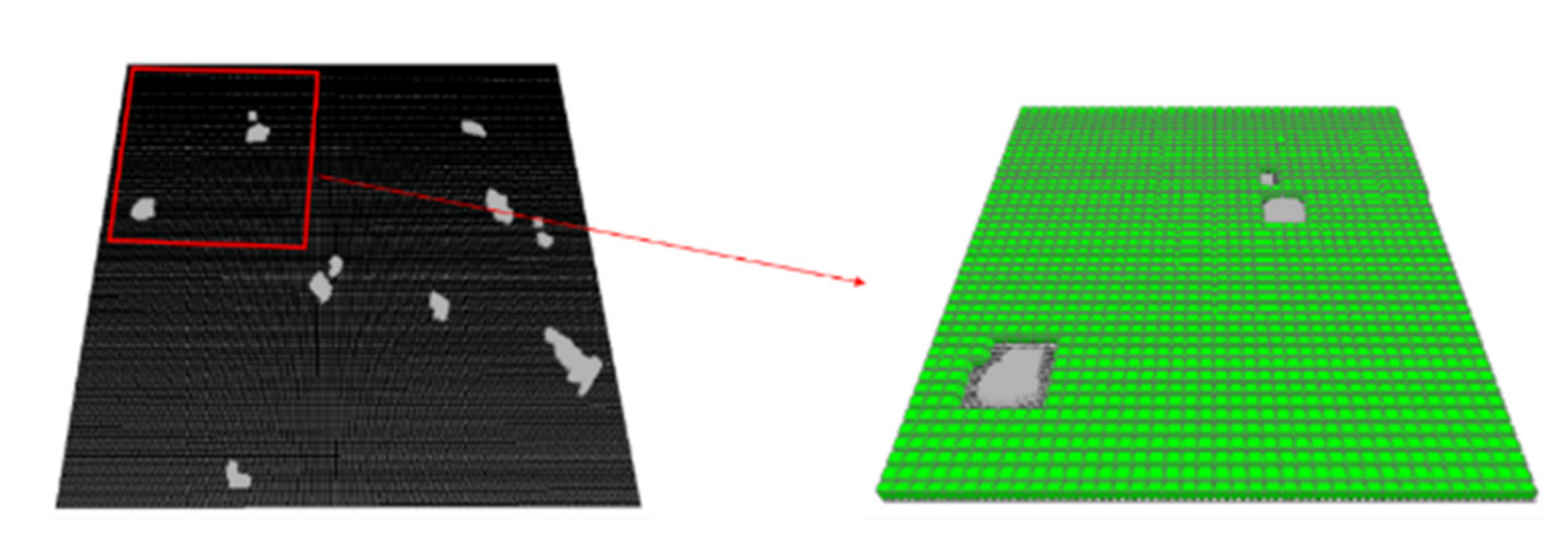
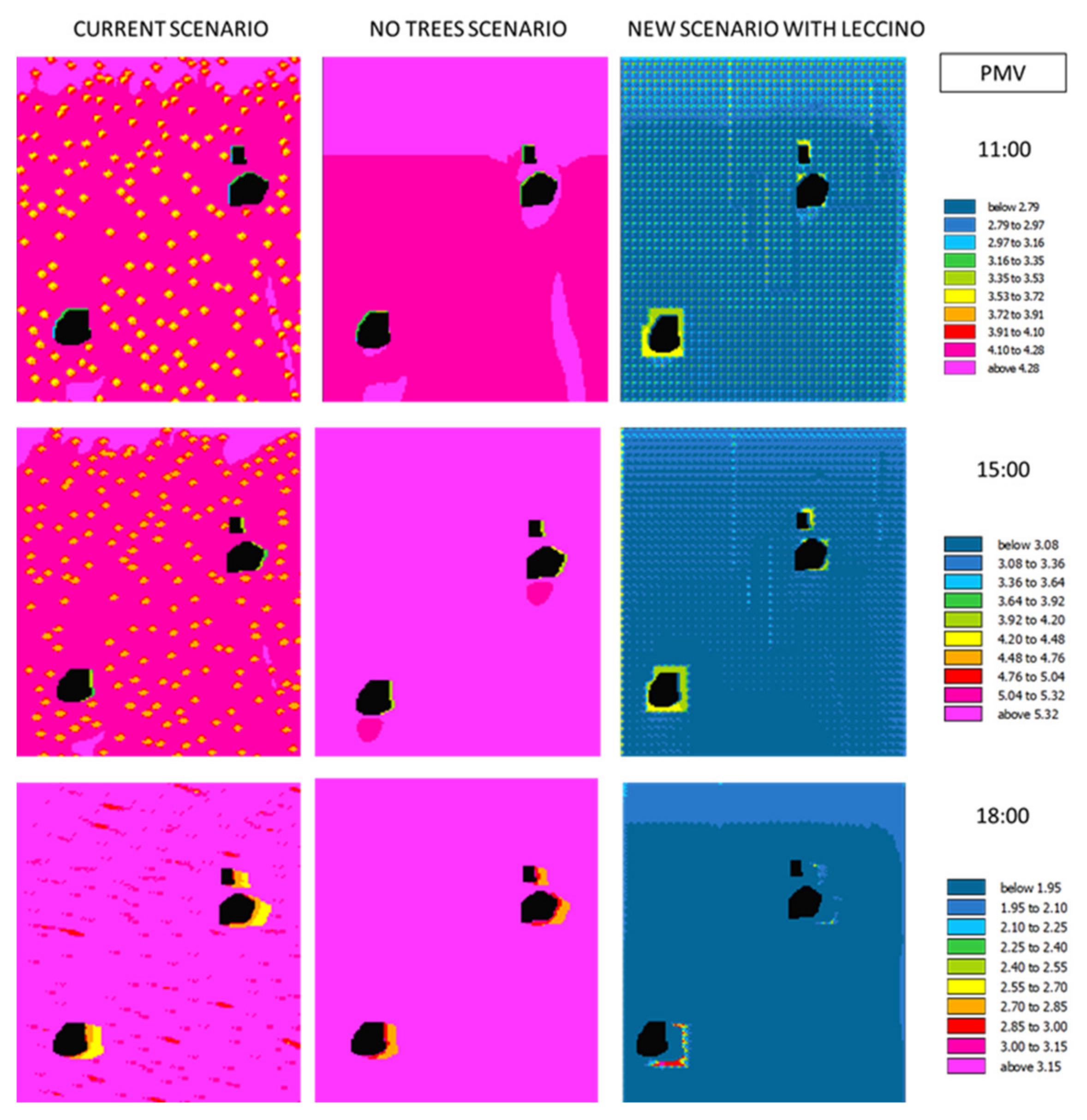
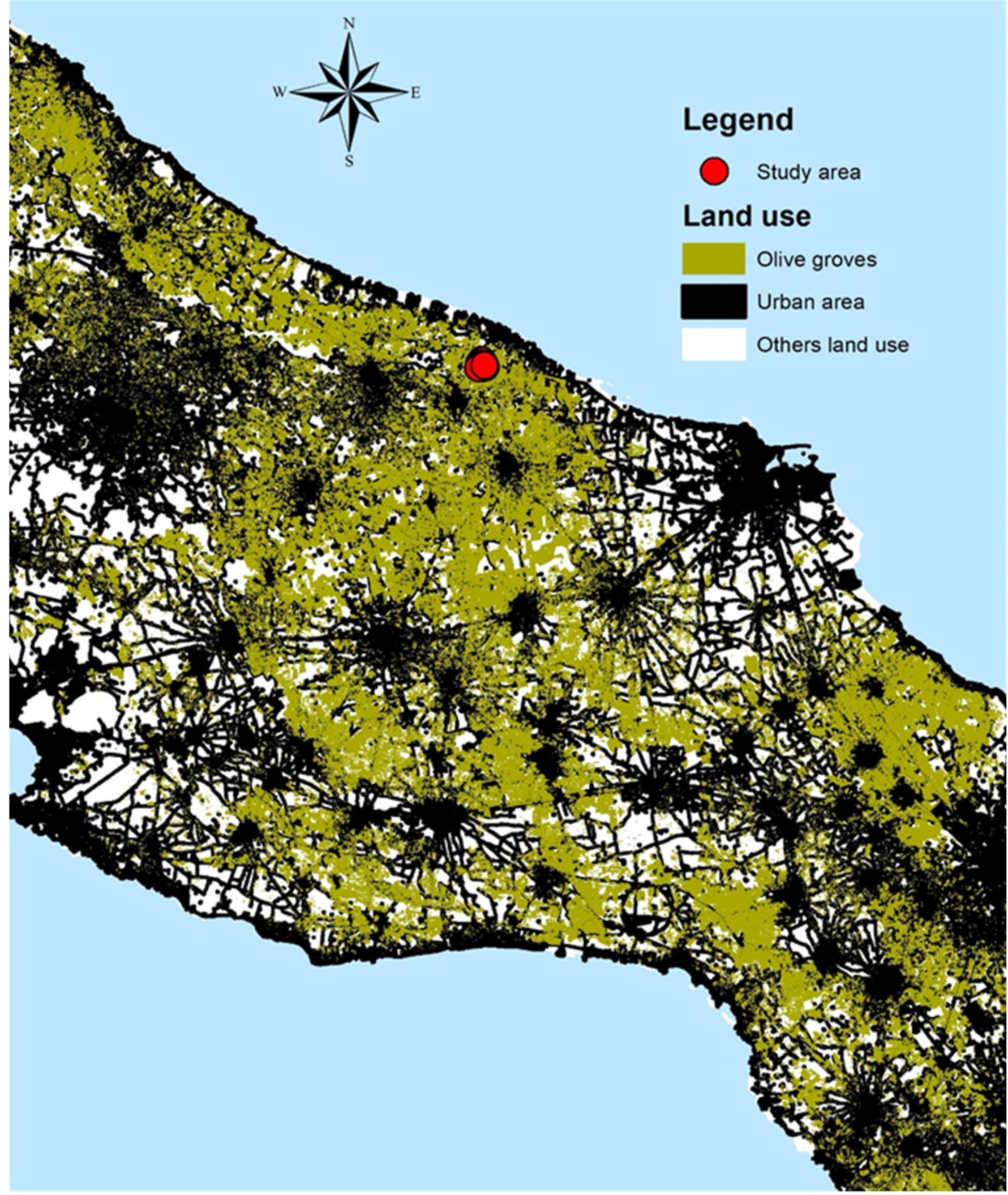
| 2010 | 2018 | Changes from 2010 to 2018 | ||||
|---|---|---|---|---|---|---|
| ha | % | ha | % | ha | % | |
| Forest and shrub | 5 | 3 | 5 | 3 | 0 | 0 |
| Grasslands | 3 | 2 | 3 | 2 | 0 | 0 |
| Olive groves | 162 | 89 | 160 | 88 | −2 | −1.2 |
| Quarry | 5 | 3 | 5 | 3 | 0 | 0 |
| Built constructions | 8 | 4 | 10 | 5 | 2 | 25 |
| Total | 182 | 100 | 182 | 100 | ||
| Functions | Ecosystem Services | New Olive Groves | Others Agricultural Varieties | References | |
|---|---|---|---|---|---|
| “Regulation functions” | Gas regulation | “UVB-protection by O3 (preventing disease). Maintenance of (good) air quality Influence on climate.” | Resilient | resilient | [16,56,57,58,59,60,61,62] Local Expert Involvement |
| Climate regulation | “Maintenance of a favorable climate (temp., precipitation, etc.) for human habitation, health, cultivation.” | resilient | resilient | ||
| Disturbance prevention | “Storm protection (e.g., by coral reefs Flood prevention (e.g., by wetlands and forests)” | resilient | resilient | ||
| Water regulation | “Drainage and natural irrigation.” | resilient | resilient | ||
| Water supply | “Provision of water quality (e.g., drinking, irrigation, and industrial use)” | not applicable | not applicable | ||
| Soil retention | “Maintenance of arable land Prevention of damage from erosion/siltation.” | resilient | resilient | ||
| Soil formation | “Maintenance of productivity on arable land. Maintenance of natural productive soils.” | resilient | resilient | ||
| Nutrient regulation | “Maintenance of healthy soils and productive ecosystems.” | resilient | resilient | ||
| Waste treatment | “Pollution control/detoxification; Filtering of dust particles (air quality) Abatement of noise pollution.” | not applicable | not applicable | ||
| Pollination | “Pollination of wild plant species Pollination of crops.” | not applicable | not applicable | ||
| Biological control | “Control of pests and diseases Reduction of herbivory (crop damage)” | not applicable | not applicable | ||
| “Habitat functions” | Refugium function | “Maintenance of biological and genetic diversity” | adaptation | adaptation | [16,58,60,62] Local Expert Involvement |
| Nursery function | “Maintenance of commercially harvested species” | adaptation | adaptation | ||
| “Production functions” | Food | “Hunting, game, fruits, etc. Small-scale subsistence” | resilient | adaptation | [16,58,60,62,63] Local Expert Involvement |
| Raw materials | “Building and Manufacturing (e.g., lumber) Fuel and energy (e.g., fuelwood)” | resilient | resilient | ||
| Genetic resources | “Improve crop resistance to pathogens and pests. Other applications (e.g., health care)” | adaptation | not resilient | ||
| Medicinal resources | “Drugs and pharmaceuticals; Chemical models and tools; Test and essay organisms.” | not applicable | not applicable | ||
| “Information functions” | Aesthetic information | “Enjoyment of scenery (scenic roads, housing, etc.)” | not resilient | not resilient | [15,58,62,63] Interview of the owner |
| Re-creation | “Travel to agroecosystems for eco-tourism and (recreational) nature study.” | resilient | resilient | ||
| Cultural and artistic information | “Use of nature as motive in books, landscape symbol and arts.” | adaptation | not resilient | ||
| Spiritual and historical information | “Use of nature for religious or historical purposes (i.e., the heritage value of natural ecosystems and features).” | not resilient | not resilient | ||
| Science and education | “Use of natural systems for education. Use of nature for research.” | adaptation | adaptation | ||
| “Carrier functions” | Habitation | “Living space (ranging from small settlements to urban areas).” | adaptation | adaptation | Interviews to the owners |
| Tourism-facilities | “Tourism-activities (outdoor sports, walking, etc.).” | adaptation | adaptation | ||
| Scenarios | Degree of Agreement |
|---|---|
| New olive trees | 80% |
| Ornamental plants typical of the place | - |
| Agricultural plants of any type, even exotic | - |
| Only agricultural plants typical of the place | - |
| Ornamental trees plants, also exotic | - |
| Plants, regardless of the type, which over time can take on a pleasant appearance, such as historic-monumental olive trees | 20% |
Publisher’s Note: MDPI stays neutral with regard to jurisdictional claims in published maps and institutional affiliations. |
© 2021 by the authors. Licensee MDPI, Basel, Switzerland. This article is an open access article distributed under the terms and conditions of the Creative Commons Attribution (CC BY) license (https://creativecommons.org/licenses/by/4.0/).
Share and Cite
Semeraro, T.; Gatto, E.; Buccolieri, R.; Catanzaro, V.; De Bellis, L.; Cotrozzi, L.; Lorenzini, G.; Vergine, M.; Luvisi, A. How Ecosystem Services Can Strengthen the Regeneration Policies for Monumental Olive Groves Destroyed by Xylella fastidiosa Bacterium in a Peri-Urban Area. Sustainability 2021, 13, 8778. https://doi.org/10.3390/su13168778
Semeraro T, Gatto E, Buccolieri R, Catanzaro V, De Bellis L, Cotrozzi L, Lorenzini G, Vergine M, Luvisi A. How Ecosystem Services Can Strengthen the Regeneration Policies for Monumental Olive Groves Destroyed by Xylella fastidiosa Bacterium in a Peri-Urban Area. Sustainability. 2021; 13(16):8778. https://doi.org/10.3390/su13168778
Chicago/Turabian StyleSemeraro, Teodoro, Elisa Gatto, Riccardo Buccolieri, Valentina Catanzaro, Luigi De Bellis, Lorenzo Cotrozzi, Giacomo Lorenzini, Marzia Vergine, and Andrea Luvisi. 2021. "How Ecosystem Services Can Strengthen the Regeneration Policies for Monumental Olive Groves Destroyed by Xylella fastidiosa Bacterium in a Peri-Urban Area" Sustainability 13, no. 16: 8778. https://doi.org/10.3390/su13168778
APA StyleSemeraro, T., Gatto, E., Buccolieri, R., Catanzaro, V., De Bellis, L., Cotrozzi, L., Lorenzini, G., Vergine, M., & Luvisi, A. (2021). How Ecosystem Services Can Strengthen the Regeneration Policies for Monumental Olive Groves Destroyed by Xylella fastidiosa Bacterium in a Peri-Urban Area. Sustainability, 13(16), 8778. https://doi.org/10.3390/su13168778












